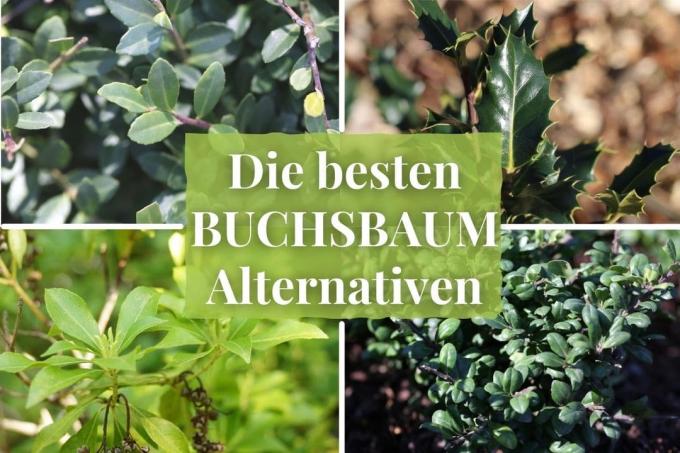
table of contents
- Boxwood alternatives from E to G
- Boxwood alternatives from H to P
- frequently asked Questions
The boxwood has been severely damaged by the boxwood moth, an introduced pest, for years. Regardless of whether you have used the boxwood as a specimen plant, hedge shrub or border, there are alternatives for all possible uses.
In a nutshell
- many alternatives for versatile boxwood
- low-growing varieties are suitable as border borders
- classic hedge plants such as arborvitae or cherry laurel as a hedge substitute
- Alternatives such as lavender or privet are an important source of nutrition for beneficial insects
- Fast-growing trees such as purple willow or yew can quickly close gaps in box hedges
Boxwood alternatives from E to G
Real lavender (Lavandula angustifolia)

- Height: 25 to 40 cm
- Width: 20 to 40 cm
- Annual growth: 2 to 5 cm
- Flowers: purple, spike-shaped, June to September
- Leaves: elongated, silvery, evergreen
- Soil: dry, poor in nutrients, calcareous
- Use: border, specimen plant
- popular insect plant
- very easy to care for
- Cutting back inflorescences encourages a second flowering in autumn
- Multiple use as a scented and aromatic plant possible
Yew tree (Taxus baccata)
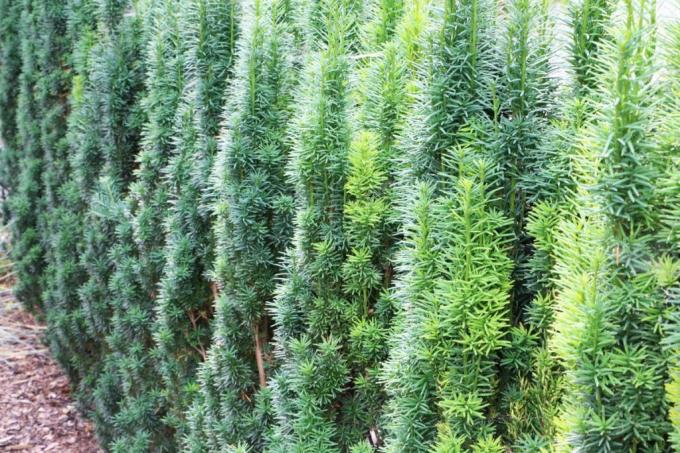
- Height: 200 to 1000 cm
- Width: 70 to 800 cm
- Annual growth: 20 to 30 cm
- Flower: inconspicuous
- Leaves: dark green, needle-shaped, leathery, evergreen
- Soil: undemanding
- Use: hedge plant, specimen plant
- very cut compatible
- quickly forms a thick hedge
Note: The yew tree is a rapidly growing substitute for box hedges that have been affected by pests. Yew trees can close this gap within a short period of time.
Common hawthorn (Crataegus monogyna)
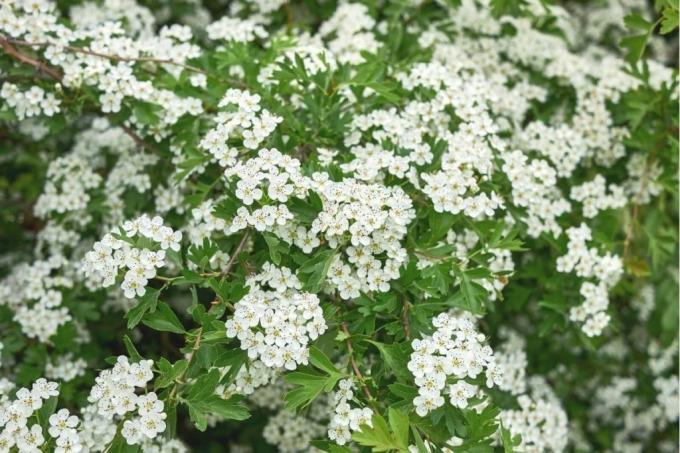
- Height: 200 to 500 cm
- Width: 100 to 300 cm
- Annual growth: 20 to 25 cm
- Flowers: white, umbel-like, May to June
- Leaves: deciduous, lobed, dark green
- Soil: undemanding, nutrient-rich and calcareous soils preferred
- Use: hedge plant
- intense fragrance
- red berries as a fruit decoration
- Flowers are popular with insects and fruits with birds
- Regular pruning creates a dense hedge, even in winter
European holly (Ilex aquifolium "Heckenzwerg")
- Height: 10 to 50 cm
- Width: 5 to 30 cm
- Annual growth: 2 to 3 cm
- Blossom: white, rarely blossoms
- Leaves: dark green, lanceolate, with thorns on the leaf margin, evergreen
- Soil: normal garden soil
- Use: edging of beds
- ideal replacement for boxwood as a border
- easy poisonous
Tip: Other varieties of European holly are also an alternative to boxwood as a hedge or solitary plant. They reach a height of up to 150 cm and have an attractive red fruit decoration.
Garden cypress (Chamaecyparis lawsoniana)

- Height: 350 to 500 cm
- Width: 130 to 250 cm
- Annual growth: 10 to 20 cm
- Flowering: inconspicuous, April
- Leaves: light green, scale-like, evergreen
- Soil: undemanding, does not tolerate waterlogging
- Use: hedge plant
- should not be planted along roads, as it is not tolerant of salt
- very easy to cut
- particularly hardy
Green cushion barberry (Berberis buxifolia 'Nana')

- Height: 40 to 75 cm
- Width: 50 to 80 cm
- Annual growth: 5 to 10 cm
- Flower: yellow, May to June
- Leaves: dark green, ovate, evergreen
- Soil: undemanding
- Use: edging of beds
- suitable as grave planting
- easy-care
- already grows naturally as a small, round dwarf shrub
Boxwood alternatives from H to P
Hedge myrtle (Lonicera nitida)

- Height: 80 to 100 cm
- Width: 80 to 100 cm
- Annual growth: 15 to 25 cm
- Flowers: creamy white, May
- Leaves: oval, glossy, evergreen, light green
- Soil: undemanding
- Use: Hedge plant, Specimen plant
- forms red berries
- very good alternative for topiary trees
- should be sheltered from the wind
- suitable for partial shade
Japanese spindle bush (Euonymus japonicus)
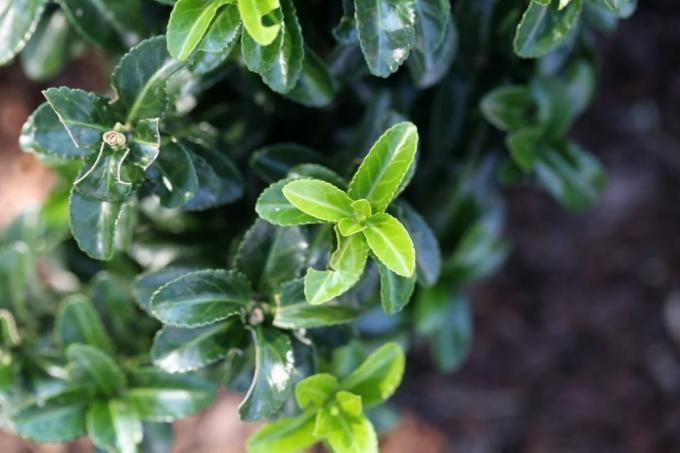
- Height: 50 to 100 cm
- Width: 20 to 50 cm
- Annual growth: 5 to 10 cm
- Flower: inconspicuous
- Leaves: elliptical, glossy, dark green, evergreen
- Soil: fresh, humus, rich in nutrients
- Use: hedge plant, bed border, specimen plant
- hardy
- weak and compact growth
- very easy to cut
Japan holly (Ilex crenata)
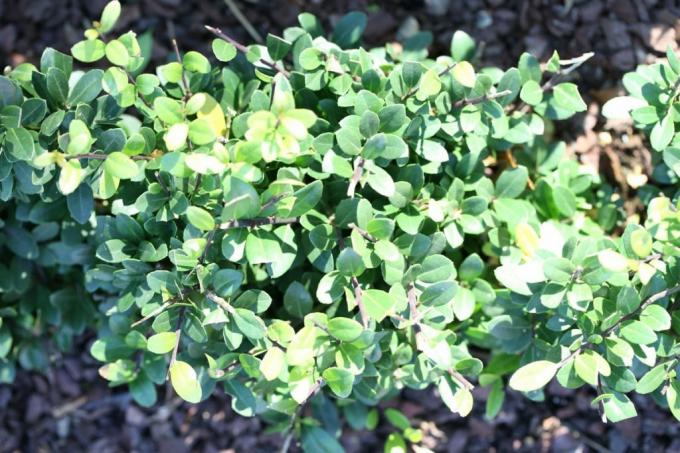
- Height: 200 to 350 cm
- Width: 100 to 300 cm
- Annual growth: 25 to 50 cm
- Flowers: white, inconspicuous, May to June
- Leaves: dark green, glossy, elliptical, evergreen
- Soil: undemanding, nutrient-rich and lime-poor soils preferred
- Use: hedge plant, specimen plant
- easy-care
- very hardy
- Cut compatible, substitute for boxwood as topiary
- suitable for shady locations
Lavender heather (Leucothoe axillaris)
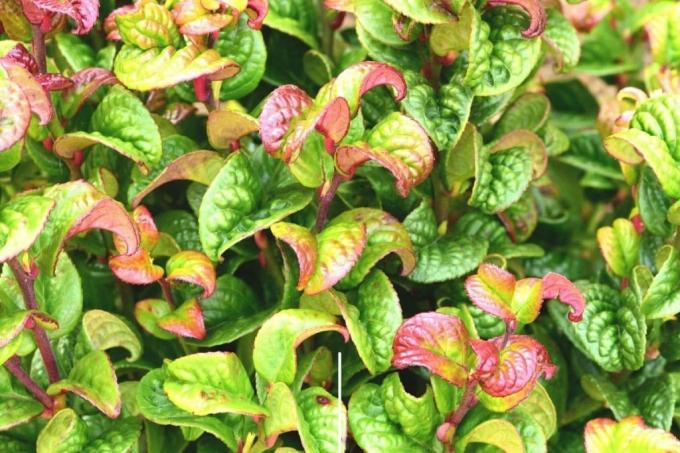
- Height: 30 to 45 cm
- Width: 30 to 45 cm
- Annual growth: 5 to 8 cm
- Flowers: white, May to June
- Leaves: elliptical, evergreen
- Soil: humic, well-drained, slightly acidic
- Use: edging of beds
- attractive autumn colors
Arborvitae (Thuja occidentalis)

- Height: 400 to 600 cm
- Width: 70 to 150 cm
- Annual growth: 10 to 30 cm
- Flower: inconspicuous
- Leaves: scaly, dark green, evergreen
- Soil: undemanding
- Use: hedge perennial
- Alternative to boxwood hedges
- easy-care
- moderately sensitive to heat
Tip: Varieties with other colors, for example the gold-colored Thuja occidentalis "Sunkist", can be a visual loosening up in a hedge.
Portuguese laurel cherry (Prunus lusitanica)

- Height: 200 to 400 cm
- Width: 100 to 150 cm
- Annual growth: 10 to 30 cm
- Flowers: white, racemose, June
- Leaves: evergreen, ovate, pointed, leathery, dark green
- Soil: normal garden soil
- Use: hedge perennial
- cut compatible
- intensely fragrant flowers
- Flowers popular with insects
- Birds like to eat fruit decorations
Purple willow (Salix purpurea)

- Height: 300 to 450 cm
- Width: 250 to 450 cm
- Annual growth: 20 to 60 cm
- Flowers: inconspicuous, medium-sized catkins, March to April
- Leaves: lanceolate, deciduous, green on top and silvery underneath
- Soil: undemanding, moist and chalky soils preferred
- Use: hedge plant, specimen plant
- regular pruning creates many branches and good privacy protection even without foliage
- very heat tolerant
- Flowers are an important source of nutrition for insects in spring
Shadow bells (Pieris japonica)

- Height: 50 to 80 cm
- Width: 60 to 100 cm
- Annual growth: 5 to 8 cm
- Flowers: white, panicle-shaped, March to April
- Leaves: medium green, elliptical, evergreen
- Soil: fresh, humic, well-drained, slightly acidic
- Use: border edging, solitary shrub
- Conditionally frost-resistant, in late frosts new shoots can freeze off
- richly blooming
- low nutritional requirements
Asterisk shrub (Deutzia magnifica)

- Height: 200 to 300 cm
- Width: 200 to 250 cm
- Annual growth: 20 to 40 cm
- Blossom: depending on the variety, pink or white, May to June
- Leaves: dark green, sharply toothed, deciduous
- Soil: humic, fresh
- Use: hedge plant, specimen shrub
- unfilled varieties are particularly popular with insects
- cut compatible
- very hardy
White dogwood (Cornus alba)
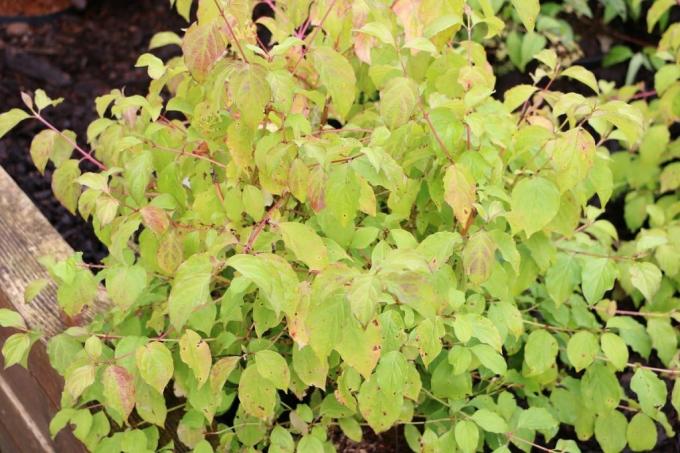
- Height: 200 to 400 cm
- Width: 200 to 400 cm
- Annual growth: 20 to 25 cm
- Flowers: white, May to June
- Leaves: red-green, lanceolate, tapering to a point
- Soil: humic
- Use: hedge plant, specimen shrub
- attractive play of colors in the leaves
- easy-care
Zwergliguster (Ligustrum vulgare "Lodense")

- Height: 70 to 100 cm
- Width: 70 to 100 cm
- Annual growth: 5 to 10 cm
- Flowers: white, panicle-shaped, June to July
- Leaves: evergreen, elliptical, narrow
- Soil: undemanding
- Use: Hedge plant, also suitable to a limited extent as a border
- attractive reddish leaf color in autumn
- Flowers popular with insects
Dwarf rhododendron (Rhododendron micranthum)
- Height: 50 to 100 cm
- Width: 50 to 120 cm
- Annual growth: 5 to 10 cm
- Flower: pink, April to May
- Leaves: small, leathery, pointed, shiny
- Soil: fresh, loose, lime-tolerant
- Use: border of beds, solitary plant
- Shallow root
- hardy
- cut compatible
Note: So far, only the “Bloombux” variety has been available in stores.
Dwarf sea buckthorn (Hippophae rhamnoides)

Source: Krzysztof Ziarnek, Kenraiz, Hippophae rhamnoides 'Hikul' kz01, Edited by Plantopedia, CC BY-SA 4.0
- Height: 100 to 150 cm
- Width: 100 to 150 cm
- Annual growth: 5 to 25 cm
- Flowers: green-brown, March to April
- Leaves: silvery, green, lanceolate, evergreen
- Soil: sandy, well-drained, salt-tolerant
- Use: hedge plant, specimen plant
- only produces orange-colored fruits when female and male plants are present
- Fruit decorations popular with birds
- also suitable for very dry locations
frequently asked Questions
A combination of different ornamental trees is not advisable, as they often have different requirements in terms of location or maintenance. An alternative to a visually uniform planting is the variation of varieties within a species. There are variegated varieties of the European yew, for example, as well as the tree of life, which can be combined with one another within their species.
Yes, there are some species in a hedge in particular, such as the yew or the Portuguese laurel cherry, which you can use to quickly fill in or out gaps. can gradually replace damaged plants. When planting in groups, replacing individual box trees can even save remaining plants, as they are no longer as attractive to the box tree moth as individual plants.
Yes, many substitute varieties have comparable leaves and are also evergreen. A difference between the species is often only noticeable on closer inspection. If you intend to replace damaged plants as unnoticed as possible, there are alternatives with comparable foliage such as the hedge myrtle.
